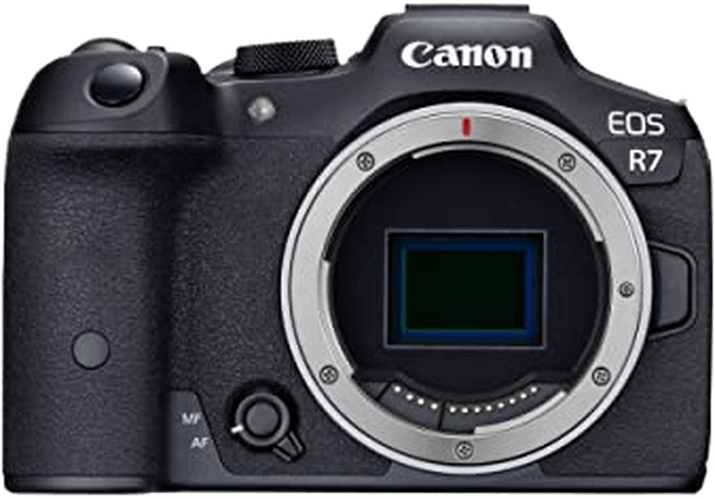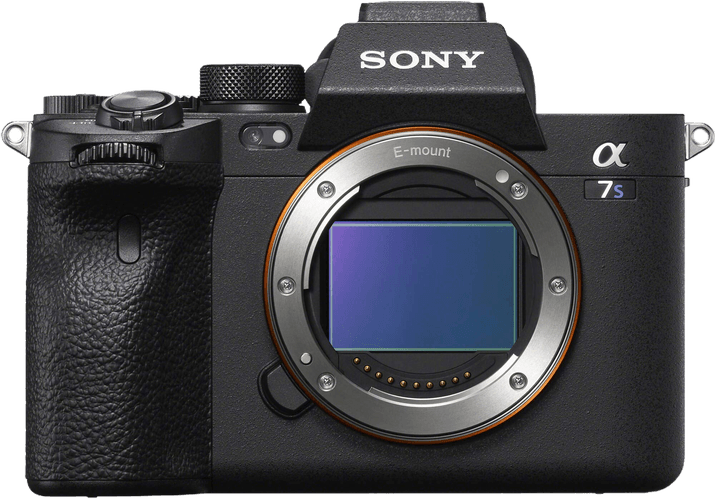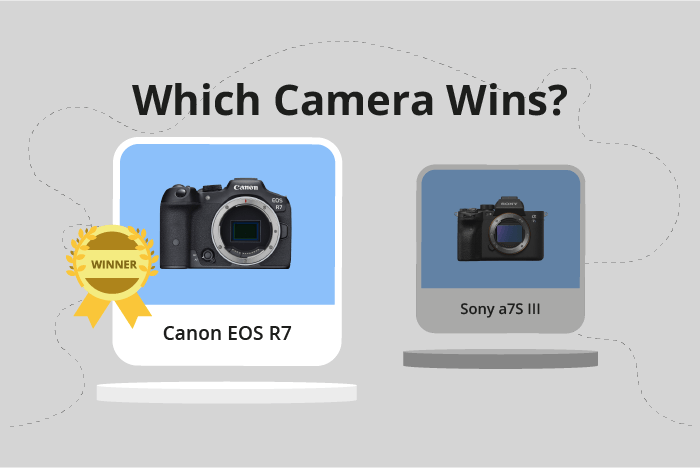Canon EOS R7 vs Sony a7S III Comparison
Canon EOS R7

Sony a7S III

The Canon EOS R7 outperforms the Sony a7S III with a score of 83/100 compared to 74/100. Both cameras are mirrorless and share similarities in size and weight, with the Canon EOS R7 measuring 132 x 90 x 92mm and weighing 612g, while the Sony a7S III is slightly smaller and heavier at 129 x 97 x 81mm and 699g.
The Canon EOS R7 has an advantage in its 2022 release year and more affordable launch price of $1500 compared to the Sony a7S III’s 2020 release and $3499 price tag. However, the Sony a7S III may still have its loyal fans due to its compact design and established reputation in the market.
Considering these points, the Canon EOS R7 is the better choice for those seeking a more recent and budget-friendly option, while the Sony a7S III may appeal to those who prioritize a smaller form factor and brand loyalty.
Canon EOS R7 vs Sony a7S III Overview and Optics
The Canon EOS R7 outperforms the Sony a7S III in optics with a score of 82/100, a 13-point lead over the Sony’s 69/100. Both cameras share several specifications, including CMOS sensor type, image stabilisation, and lens mounts compatible with their respective brands.
The Canon EOS R7 excels with its 33-megapixel sensor, providing greater resolution and detail compared to the Sony a7S III’s 12.1-megapixel sensor. Additionally, the Canon’s shooting speed of 15 frames per second is faster than the Sony’s 10 frames per second. The EOS R7’s Digic X processor and higher DXOMARK sensor score of 97 contribute to better performance in processing and image quality. Furthermore, the Canon EOS R7 features an APS-C sensor size, which offers a balance between image quality and portability.
On the other hand, the Sony a7S III has a full-frame sensor, providing a larger surface area for light capture and potentially better low-light performance. However, its lower megapixel count, shooting speed, and DXOMARK sensor score of 86 result in inferior optics compared to the Canon EOS R7.
Considering these factors, the Canon EOS R7 stands as the superior choice for optics, with higher resolution, faster shooting speed, and a better processor. The Sony a7S III may offer advantages in low-light situations due to its full-frame sensor, but its overall performance falls short in comparison. Therefore, photographers seeking the best optics should opt for the Canon EOS R7, while those prioritizing low-light capabilities may find value in the Sony a7S III.
Canon EOS R7 vs Sony a7S III Video Performance
The Canon EOS R7 outperforms the Sony a7S III in video capabilities with a score of 91/100 compared to the Sony’s 77/100. Both cameras offer 4K video resolution and have maximum video dimensions of 3840 x 2160. Additionally, they both provide a maximum video frame rate of 120fps.
The Canon EOS R7 surpasses the Sony a7S III due to its built-in time-lapse functionality. This feature allows users to capture stunning time-lapse videos without the need for external equipment or software, providing more convenience and creative opportunities for videographers.
On the other hand, the Sony a7S III does not have built-in time-lapse functionality. This means that users must rely on external equipment and software to create time-lapse videos, which may be less convenient for some videographers. Despite this disadvantage, the Sony a7S III still offers excellent video quality with its 4K resolution and 120fps frame rate, matching the Canon EOS R7 in these aspects.
Comparing both cameras, the Canon EOS R7 holds a clear advantage in video capabilities due to its built-in time-lapse functionality. This feature makes it more versatile and user-friendly for videographers who wish to create time-lapse videos without additional equipment. The Sony a7S III, while lacking this feature, still delivers high-quality video performance with its 4K resolution and 120fps frame rate. Considering these factors, the Canon EOS R7 stands out as the superior choice for videographers seeking advanced video capabilities in their camera.
Canon EOS R7 vs Sony a7S III Features and Benefits
The Canon EOS R7 emerges as the winner with a feature score of 85/100, compared to the Sony a7S III’s 83/100. Both cameras share several specifications, such as a 3-inch screen size, touchscreen capabilities, flip screen, and the absence of GPS. Additionally, both cameras are equipped with WIFI and Bluetooth connectivity.
The Canon EOS R7 outperforms the Sony a7S III in screen resolution, with an impressive 1,620,000 dots, while the Sony a7S III trails behind at 1,440,000 dots. This higher resolution allows the Canon EOS R7 to deliver crisper and more detailed images during image playback and menu navigation, providing a better user experience.
However, the Sony a7S III is not without its advantages. Although it has a slightly lower feature score, this difference of two points does not significantly impact the camera’s overall performance. Both cameras offer a range of features suitable for various photography and videography needs, and the choice between the two ultimately depends on individual preferences and requirements.
To sum up, the Canon EOS R7 takes the lead in terms of features, mainly due to its superior screen resolution, which contributes to a better viewing experience. The Sony a7S III, while slightly behind in score, remains a strong contender and a capable camera. Photographers and videographers must consider their specific needs and preferences when choosing between these two high-quality cameras.
Canon EOS R7 vs Sony a7S III Storage and Battery
The Canon EOS R7 wins the storage and battery comparison with a score of 79/100, while the Sony a7S III scores 76/100. Both cameras have two memory card slots and accept SD, SDHC, and SDXC (UHS-II compatible) cards. They also both offer USB charging.
The EOS R7 outperforms the a7S III in battery life, providing 660 shots per charge with its LP-E6NH battery, compared to the a7S III’s 600 shots using the NP-FZ100 battery. This difference gives the EOS R7 an edge for extended shooting sessions.
However, the Sony a7S III has an advantage in memory card compatibility, as it also supports CFexpress Type A cards, providing users with more storage options.
Taking these factors into account, the Canon EOS R7 offers superior battery life, while the Sony a7S III provides more versatile storage options.
Canon EOS R7 vs Sony a7S III – Our Verdict
Are you still undecided about which camera is right for you? Have a look at these popular comparisons that feature the Canon EOS R7 or the Sony a7S III:

